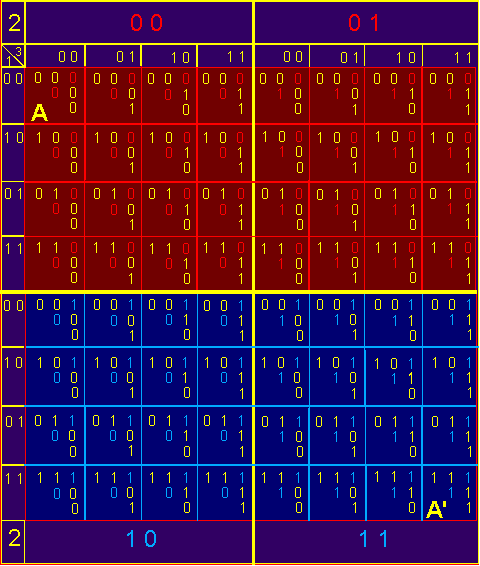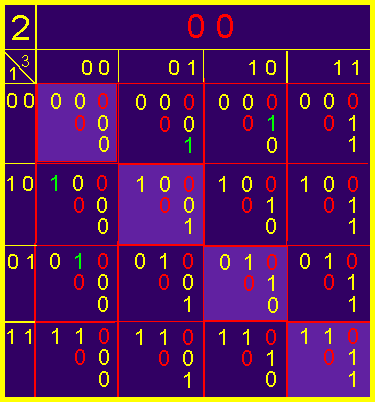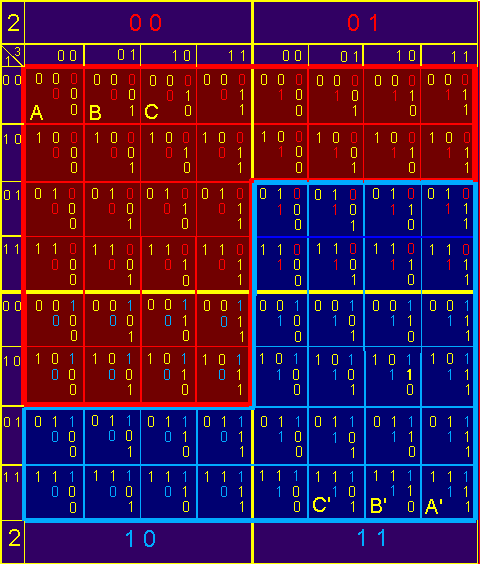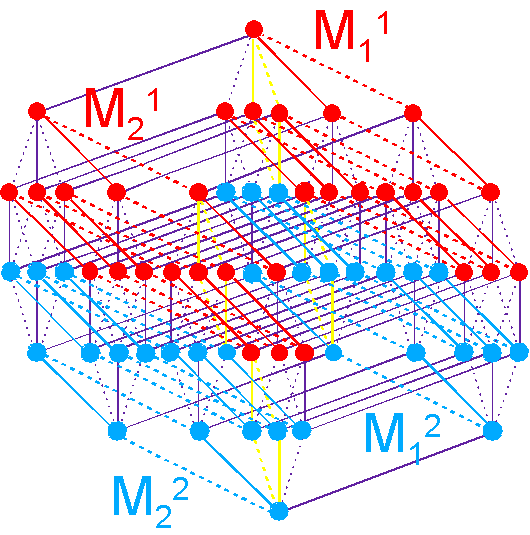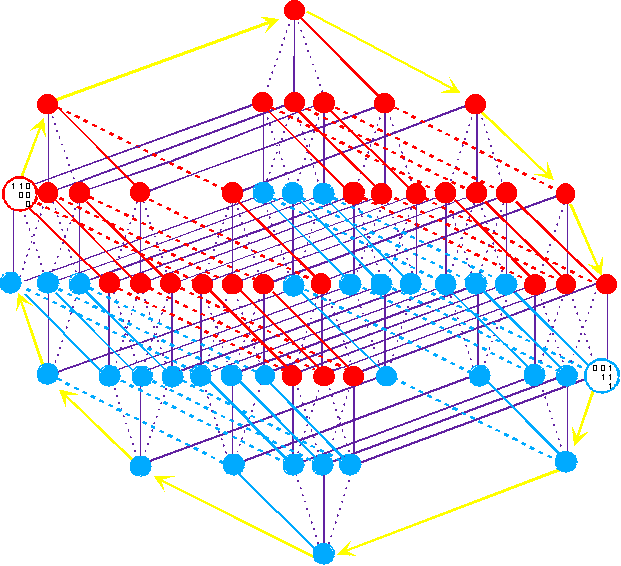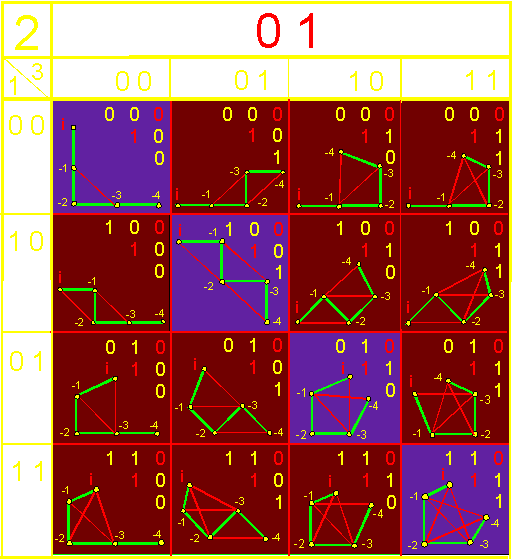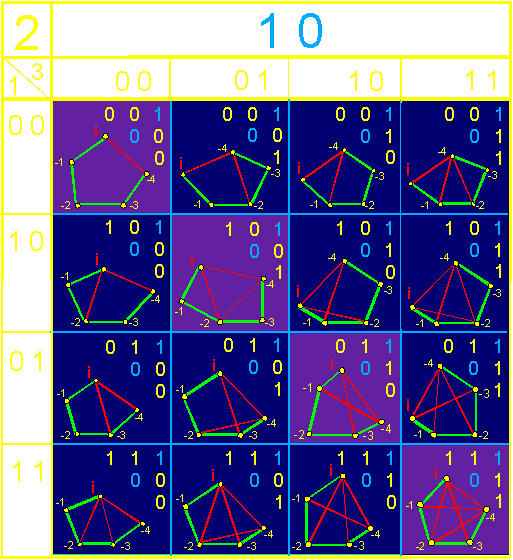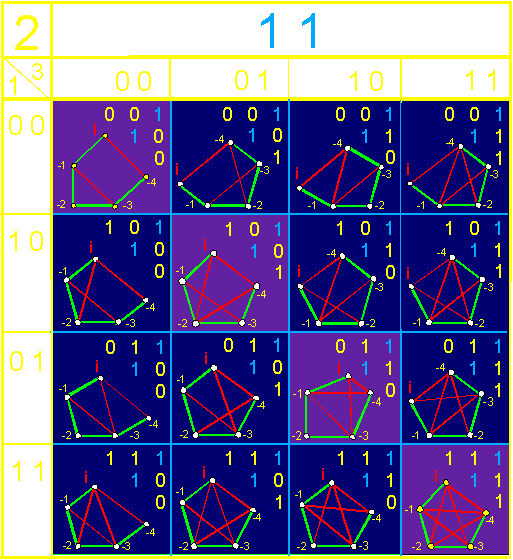3.2. Supermatrix of conformations of 4-arc
graph and its spatial
representation
3.2.1. Construction and properties of the Supermatrix
consisting of triangular matrixes
To begin, we will construct the Supermatrix of triangular
matrices describing the conformation
of the 4-arc graph and study its properties. There
are 26 upper triangular matrices, consisting of six variables, i.e., only 64. We have arranged these matrices in increase of connectivity degree
of the graph described by them.
The arrangement of matrices can be carried out in different ways, for example, so that the
adjacent matrix in
rows and columns differ from each other
by one bit [5]. However
such principle of an arrangement comes to the contradiction with principles of
assignment triplets and amino acids (see the section. 3.3.),
therefore the
preferred variant was
an arrangement of matrices in the form of blocks (fig. 24). Let's consider the basic properties of the block
Supermatrix.
|
BLOCK STRUCTURE |
|
|
The
principle of ordering of triangular matrices in the form of blocks is based on the fact that matrices
of each block are grouped on the basis of a community of the
second pair variables - x3x4. (see Section 3.1.2.). In this case, as
shown in Figure 24, in the first block (at the left above), in the upper left corner is the
matrix A, describing non spiral conformation (fully disconnected graph) that
contains only zeros, and the fourth block (on the right below) in the lower right corner settled
matrix A ', describing the helical conformation of the graph (fully connected
graph) consisting of all ones. |
|
|
The
Supermatrix consists of 4 blocks (Fig. 24). In each block consisting of 16 matrices, the second pair of variables x3x4 is identical. In accordance with
the values of these variables
blocks are designated by large figures: 00, 01 (the upper blocks) 10, 11 (the bottom blocks). In blocks 00 and 01 x3 = 0. These blocks are marked with
a red-brown color. In blocks 10 and 11 x3 = 1.
They are painted dark blue. In each block in the rows are the matrices having the
same first pair of variables, they are shown on the left side. The
order of raws 00,
10, 01, 11. The columns are matrices with identical third pairs of variables, which are shown above. The sequence of columns 00, 01, 10, 11. |
|
|
Fig.
24. Construction of a block
supermatrix from 64 triangular
matrices describing the conformation
of the 4-arc graph. |
|
|
SYMMETRY IN BLOCKS |
|
|
|
On the main diagonal of each block (for example,
the block 00) are matrices in which the first
pair of variables is symmetric
to the third pair: 000000, 100001 etc. Matrices in which the first pair of variables is symmetric to the third pair are located symmetrically concerning the main diagonal
for example 100000 and 000001, 010000
and 000010, etc. |
|
Fig. 25. Symmetry of triangular matrixes in
the block 00. |
|
|
ANTISYMMETRY |
|
|
Within the
supermatrix each matrix has the antipode in which values 0 turn to 1,
and 1 - to 0,
i.e. 0 <--->
1. The matrices connected by these
transformation are located rotational symmetric (group of symmetry С2), for example: 000000 and 111111
(A и A'), 000001 and 111110
(B и B'), 000010 and 111101
(C и C'). Two groups of antisymmetric matrices
can be identified in different ways.
We have chosen variant
(the Russian
letter "Г",
red-brown and dark blue, nested) is justified below. |
|
|
|
Fig. 26. Antisymmetry of triangular
matrices in the Supermatrix. |
|
The variant of Supermatrix cut chosen
by us at which matrices of the top part will be transformed to matrices of
the bottom half by replacement 0 <--->
1, coincides with
the natural division of the hypercube
B6
into two halves ("red" and "dark blue"), which are combined when rotated on 180о. |
|
|
In this
Supermatrix, each matrix contains
6 variables and may be connected with six other matrices differing from the original one by a single value (one-bit transitions).
This is consistent with the principle
of constructing a Boolean hypercube B6,
shown below. |
|
3.2.2. Spatial representation of a Supermatrix: Boolean hypercube B6.
|
ARRANGEMENT
OF QUARTETS OF MATRICES |
|
|
|
The series of matrices from the blocks located in a
"red-brown" part of the Supermatrix, are in the Hypercube (Fig. 27)
in "red"
quartets М11 and М21. The
series, consisting of blocks
of "dark blue" part of the Supermatrix are in "blue" Hypercube
quartets М12 and М22. Quartets of the matrices possessing symmetry of the first
and the third pairs of variables are marked by yellow color on a hypercube. . |
|
Fig. 27. An
arrangement of quartets
of triangular matrices on the Boolean hypercube B6. |
|
|
ANTISYMMETRY
TRANSFORMATION |
|
|
Triangular matrices connected by transformation of antisymmetry
(0<--->1),
are arranged symmetrical (group of symmetry С2) in the "red" and "blue"
halves of the Hypercube (Fig. 28). For
interested persons who want to reflect there is a complete structure of Нypercube В6
on a white background which can be printed. |
|
|
Fig. 28. An arrangement of matrices connected
by transformation of antisymmetry on the
Boolean hypercube B6. |
|
3.2.3. Properties of 4-arc graphs in blocks of the Supermatrix
Graphs can be
characterized by the number of degrees of freedom, i.e. possibility of graph elements
moving in three dimensions. Since the graph is connected in a chain, then its
elements can have two degrees of freedom as maximum, such as moving from side
to side or front to back. One degree of freedom and
zero degree are possible also. In
the latter case, all elements
of the graph, for example,
vertices, fully fixed. We consider the properties of graphs in each of
the four blocks of the
Supermatrix. A protein chains can be described similarly.
|
In blocks 00 and 01 x3 = 0. It means, that
between vertices i and i-4 there is no edge of connectivity and
the graphs of these blocks have not closed conformations. |
|||||
|
BLOCK 00 |
|||||
|
|
On the main diagonal of each block, for example 00
(Fig. 29), the graphs
having internal symmetry are
situated: 000000, 100001, 010010, 110011. On both sides of the main diagonal the graphs
symmetric to each other are located,
for example: 100000 and
000001,
000010 and 010000
etc. In the block 00 are
mostly weakly connected conformation, with the number of degrees of freedom 2 or 1. The only graph of the
block, with zero degree of
freedom is described by the matrix 110011. |
||||
|
Fig.
29. Weakly connected conformations of 4-arc graphs in block 00. |
|||||
|
BLOCK 01 |
|||||
|
|
||||
|
Fig.
30. The folded conformation
of the 4-arc graphs in block
01. |
|||||
|
In contrast to earlier, in blocks 10 and, discussed below, x3 = 1. Between vertices i and i-4 of these
graphs there is an edge of connectivity
and therefore they are cyclic. |
|||||
|
BLOCK 10 |
|||||
|
|
Block 10 (Fig. 31)
contains a weakly connected cyclic
conformation of the graph with the degree of freedom 1 and 2. Three
graphs have a fixed conformation (degree of freedom 0) 011011, 111010 and 111011. By their structure,
they are close to the conformation
of the protein alpha-helix (see in Section
3.1.3.). |
||||
|
Fig.
31. Movable cyclic
conformation of 4-arc graphs in block 10. |
|||||
|
BLOCK 11 |
|||||
|
In block
11 also are cyclic conformation of the graph, but they
have a much lower degree of freedom. Eight of them - 101101, 101110, 011101, 011111, 111101, 111110 and 111111 are fixed (the degree of freedom is equal to zero) and
correspond to the conformation of the
protein alpha-helical. |
|
||||
|
Fig.
31. Cyclic conformations
of 4-arc graphs in block 11. |
|||||
These graphs and their matrix
description, however, are not suitable for storage, transfer and reproduction of structural
information contained in them. For these purposes, is much more convenient
linear arrangement of elements, which can be achieved after transformation of
Supermatrix in triplet code (Section 3.3.).
